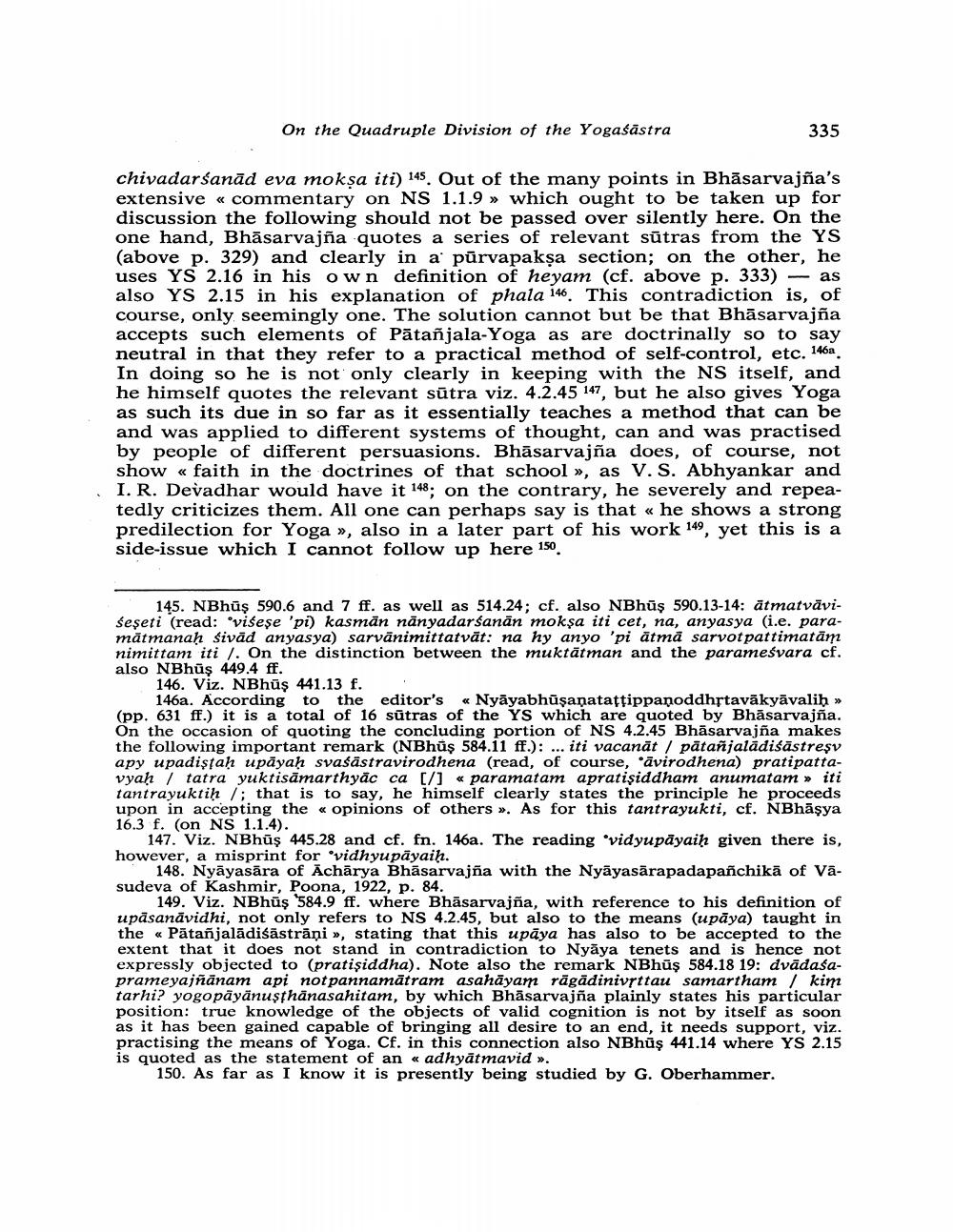________________
On the Quadruple Division of the Yogaśāstra
335
chivadarśanād eva moksa iti) 145. Out of the many points in Bhāsarvajña's extensive « commentary on NS 1.1.9 » which ought to be taken up for discussion the following should not be passed over silently here. On the one hand, Bhāsarvajña quotes a series of relevant sūtras from the YS (above p. 329) and clearly in a pūrvapaksa section; on the other, he uses YS 2.16 in his own definition of heyam (cf. above p. 333) as also YS 2.15 in his explanation of phala 146. This contradiction is, of course, only seemingly one. The solution cannot but be that Bhāsarvajña accepts such elements of Pātañjala-Yoga as are doctrinally so to say neutral in that they refer to a practical method of self-control, etc. 146a. In doing so he is not only clearly in keeping with the NS itself, and he himself quotes the relevant sūtra viz. 4.2.45 147, but he also gives Yoga as such its due in so far as it essentially teaches a method that can be and was applied to different systems of thought, can and was practised by people of different persuasions. Bhāsarvajña does, of course, not show « faith in the doctrines of that school », as V.S. Abhyankar and I. R. Devadhar would have it 148; on the contrary, he severely and repeatedly criticizes them. All one can perhaps say is that « he shows a strong predilection for Yoga », also in a later part of his work 149, yet this is a side-issue which I cannot follow up here 150.
145. NBhūş 590.6 and 7 ff. as well as 514.24; cf. also NBhūş 590.13-14: ātmatväviśeşeti (read: 'višeşe 'pi) kasmān nānyadarśanan mokşa iti cet, na, anyasya (i.e. paramătmanah Sivād anyasya) sarvānimittatvāt: na hy anyo 'pi ātmā sarvot pattimatām nimittam iti /. On the distinction between the muktātman and the parameśvara cf. also NBhūş 449.4 ff.
146. Viz. NBhūş 441.13 f.
146a. According to the editor's « Nyāyabhūşanataţtippaņoddhștavākyāvalih >> (pp. 631 ff.) it is a total of 16 sūtras of the YS which are quoted by Bhāsarvajña. On the occasion of quoting the concluding portion of NS 4.2.45 Bhāsarvajña makes the following important remark (NBhūş 584.11 ff.): ... iti vacanāt / pātañjalādiśāstresv apy upadiştah upāyaḥ svaśāstravirodhena (read, of course, Pāvirodhena) pratipattavyah / tatra yuktisāmarthyāc ca [/] « paramatam apratişiddham anumatam » iti tantrayuktih /; that is to say, he himself clearly states the principle he proceeds upon in accepting the « opinions of others ». As for this tantrayukti, cf. NBhāşya 16.3 f. (on NS 1.1.4).
147. Viz. NBhūs 445.28 and cf. fn. 146a. The reading 'vidyupāyaih given there is, however, a misprint for 'vidhyupāyaih.
148. Nyāyasāra of Āchārya Bhāsarvajña with the Nyāyasārapadapañchikā of Vā. sudeva of Kashmir, Poona, 1922, p. 84.
149. Viz. NBhūş '584.9 ff. where Bhāsarvajña, with reference to his definition of upāsanāvidhi, not only refers to NS 4.2.45, but also to the means (upāya) taught in the « Patañjalādiśāstrāņi», stating that this upāya has also to be accepted to the extent that it does not stand in contradiction to Nyāya tenets and is hence not expressly objected to (pratişiddha). Note also the remark NBhūş 584.18 19: dvādaśaprameyajñānam api not pannamātram asahāyam rāgādinivsttau samartham / kim tarhi? yogopāyānuşthānasahitam, by which Bhāsarvajña plainly states his particular position: true knowledge of the objects of valid cognition is not by itself as soon as it has been gained capable of bringing all desire to an end, it needs support, viz. practising the means of Yoga. Cf. in this connection also NBhūş 441.14 where YS 2.15 is quoted as the statement of an « adhyātmavid ».
150. As far as I know it is presently being studied by G. Oberhammer.




